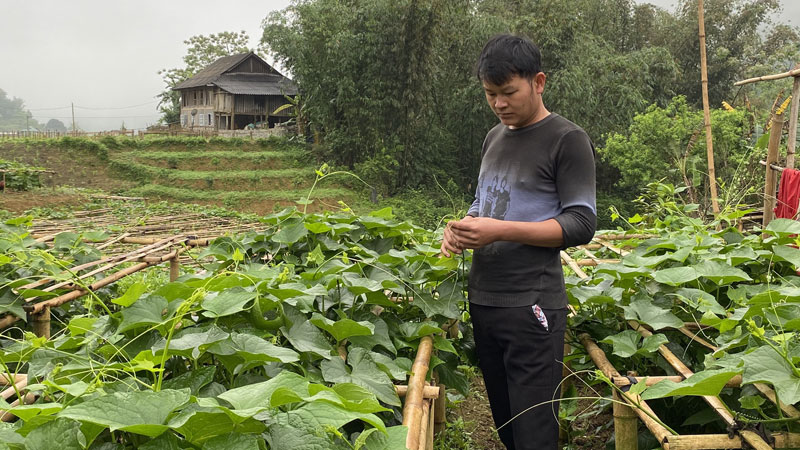
(HBO) - Taking advantage of its favourable soil and weather, Tan Lac district focuses on developing the cultivation of pomelo trees in low land areas along National Highway 12B and temperate vegetables in high land areas for improved economic benefits and living standards.
 Farmers in Tan Lac’s
Quyet Chien commune grow chayote for shoots and fruits, earning between 180 and
200 million VND per hectare.
Farmers in Tan Lac’s
Quyet Chien commune grow chayote for shoots and fruits, earning between 180 and
200 million VND per hectare.
The district has issued thematic resolutions to direct
locals to develop agricultural production in association with building
new-style rural areas. As a result, local communes and towns have switched from
rice to other crops with higher economic value on 2,500 hectares of land;
upgraded more than 670 hectares of gardens for the cultivation of pomelo trees,
watermelon, and peanut in low areas, and chayote and garlic in high areas,
among others.
Following the district Party Committee’s Resolution 10 on
promoting the cultivation of pomelo trees, the area under the citrus fruit has
expanded quickly. As of July 2020, the pomelo-cultivated areas hit 1,105 hectares,
with an average yield of 30 tonnes of fruit per ha. Each pomelo is sold for
20,000 VND, meaning a hectare of the fruit trees can reel in from 400 to 700
million VND. The fruit tree has become a key revenue earner for locals, many of
whom have invested in garden upgrade and intensive farming for better products
meeting increasing demand from the market.
In addition to pomelo, the district also prioritises
temperate vegetables, particularly chayote for its suitability for mountainous
communes’ soil and weather. The area under chayote is now around 90 hectares,
of which 65 hectares are in Quyet Chien.
Tan Lac pomelo and Quyet Chien chayote are popular
nationwide. The district has decided not to expand the plantation areas but
focusing on boosting productivity, quality, and safety.
The pomelo has been recognized as meeting the standard of
the One Commune One Product (OCOP) programme last year, while application for
provincial recognition of the chayote is pending./.
Hoa Binh province is undergoing a dynamic transformation amid Vietnam’s national digital transition. Building on Poliburo’s Resolution No. 57-NQ/TW on breakthroughs in science, technology, innovation, and national digital transformation, the province has rolled out a wide range of practical action plans. A standout initiative is the "Digital Literacy for All” movement, an effort to ensure that no one is left behind in the digital era.
Hoa Binh province is undergoing a dynamic transformation in the wake of the national digital transformation movement. Building on Resolution No. 57-NQ/TW of the Politburo on breakthroughs in science, technology, innovation, and national digital transformation, the province has implemented a wide range of practical action plans. A standout initiative is the "Digital Literacy for All” movement ambitious effort to ensure that no one is left behind in the digital age.
With a spirit of unity and proactive problem-solving, the Party Committee, the government and the people of Dong Lai Commune (Tan Lac District) have made great strides in implementing the resolutions of the 24th Party Congress of the commune for the 2020 - 2025 term. Focusing on leadership and practical actions, the commune has brought the Party’s resolutions into daily life, creating strong impacts and pushing the local development forward.
Amid the nationwide push for digital transformation, young people in Hoa Binh Province are stepping up as dynamic pioneers, applying technology to enhance Youth Union operations and expand the reach of youth-led initiatives. Through creativity and adaptability, Youth Union organizations at all levels have introduced a series of practical solutions, contributing to modern governance and community development.
In recent years, An Nghia commune, located in Lac Son district, has stepped up administrative reform, focusing on improving the quality and efficiency of its single-window service unit for receiving and processing administrative procedures. These improvements have helped create favourable conditions for local residents and organisations to handle administrative procedures, contributing to the commune’s broader socio-economic development.
The Prime Minister-approved master plan to develop the multi-use value of forests ecosystems through 2030, with a vision to 2050, aims to improve the management and sustainable use of forest resources, create jobs, increase incomes, and improve the living standards of ethnic minorities, people in mountainous and remote areas, forest workers and those living near forests.



 Farmers in Tan Lac’s
Quyet Chien commune grow chayote for shoots and fruits, earning between 180 and
200 million VND per hectare.
Farmers in Tan Lac’s
Quyet Chien commune grow chayote for shoots and fruits, earning between 180 and
200 million VND per hectare.